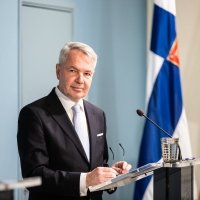Environment, Development, and Sustainable Peace: Finding Paths to Environmental Peacemaking

Download entire conference report here.
Sustainability: A Security Imperative
"Environmental security is the disarmament policy of the future." With that provocative statement, Klaus Toepfer, the executive director of the United Nations Environment Programme (UNEP), introduced UNEP's latest report, Understanding Environment, Conflict, and Cooperation, at Wilton Park, the British Foreign Office's independent center for the discussion of international issues. The conference, titled "Environment, Development, and Sustainable Peace: Finding Paths to Environmental Peacemaking," brought together 60 experts from 25 countries, including senior government representatives from the United Nations, United States, and United Kingdom, to examine the role of minerals, forests, and water resources in promoting and preventing conflict. As Hilary Benn, the United Kingdom's Secretary of State for International Development, announced in his keynote speech, "Natural resources need not be sources of conflict. Let them be sources of economic growth, community, partnership, and goodwill."
Host Roger Williamson of Wilton Park and the conference's co-organizers welcomed the attendees to Wilton Park's 758th session by describing the principles behind the concept of "sustainable peace," the goal of their Environment, Development, and Sustainable Peace (EDSP) Initiative. Created to increase North-South dialogue on environment, conflict, and cooperation, the initiative helped frame the Wilton Park conference theme: to share lessons on environmental peacemaking across natural resource sectors (forest, minerals, water) and from around the world. Alexander López, director of the National University of Costa Rica's Mesoamerican Center for Sustainable Development of the Dry Tropics in Nicoya, observed that "conflicts are unsolved development problems," but the different languages spoken by the environmental security and the development communities impede sustainable solutions. Calling for "more and better good governance," he emphasized that the environment security agenda was the same as the development agenda. Geoffrey Dabelko, director of the Environmental Change and Security Project at the Woodrow Wilson International Center for Scholars in Washington, D.C., asked attendees for practical ideas that can be implemented in the field. At the same time, he recommended that participants stretch outside of their sector, taking advantage of this unique gathering of international water, forest, and minerals experts to learn from one another.Laying the Foundation
Alexander Carius of Berlin's Adelphi Research, the third conference co-organizer, introduced the environmental peacemaking agenda by outlining the major themes of environmental security research and policy. He reviewed the scarcity thesis, which posits that lack of natural resources can contribute to conflict, and its counterpart, which argues that abundant natural resources also can contribute to conflict. Carius urged scholars and practitioners to move beyond this dichotomy, however, and focus on mobilizing shared natural resources to foster environmental cooperation and sustainable peace via "environmental peacemaking."
Environmental peacemaking brings parties in conflict together to work on environmental issues in ways that build confidence and reduce political tensions. It encompasses the entire conflict cycle, from prevention, mitigation, and management to post-conflict peace building. While environmental peacemaking encourages sustainable environmental management, its primary goals are conflict prevention and confidence building. Environmental peacemaking programmes are still in the early stages of development, and we have much to learn about the conditions required for success, but the EDSP Initiative and collaborator Ken Conca at the University of Maryland have identified some examples:
- When parties are locked in bitter conflict, environmental issues can be less contentious than other issues, providing a forum for dialogue and serving as a communication lifeline between warring groups;
- Some environmental issues (like shared water resources) may be so fundamental to social and economic development that parties in conflict cannot afford to militarize them; and
- Where political borders are in dispute, instituting joint management of abutting resource areas, or "peace parks," may reduce tension.
These examples illustrate the diversity of dynamics surrounding environmental peacemaking. Some participants argued that this lack of precision undercuts the analytical utility of the term, comparing its vagueness to "sustainable development," another phrase that holds different meanings for different audiences.
Okechukwu Ibeanu, a programme officer with the MacArthur Foundation in Abuja, Nigeria, who was recently appointed environment and human rights rapporteur for UNHCR, sought to "ground" environment, conflict, and cooperation by approaching the links from a Southern perspective. While the environmental security debate has largely been centered in Northern universities and policy circles, resource-related violent conflicts mainly occur in developing countries and therefore analysis and policymaking need to better incorporate Southern input. Ibeanu emphasized the interrelatedness of environmental and social dynamics, and pointed out that the division of these spheres reflects scientific and policy approaches, rather than local realities. Thus, it is essential to recognize this interdependence and integrate programs. Also, individualistic, Northern interpretations of security have dominated this debate, which has not sufficiently considered the social logic and community perspective found in many developing countries.
From a local perspective, environmental peacemaking is beneficial because cooperation offers the opportunity to exchange different perspectives and generate wider interest in environmental issues, in addition to the practical benefits of pooling resources and capacities. Despite this, however, some illusions hinder cooperative processes and international environmental peacemaking. On one hand, a "Southern illusion" views environmental considerations as a Northern plot to prevent the South from developing to its full capacity. On the other, a "Northern illusion" holds that technological advances will solve emerging environmental problems. To foster effective environmental peacemaking, these underlying illusions must be considered and addressed simultaneously.
Senior PerspectivesOfficials at the highest levels are turning their attention to environmental peacemaking. UNEP's Klaus Toepfer outlined his organization's "three pillars" of environment and conflict activities: first, the Post-Conflict Assessment Unit (PCAU) analyzes the impact of war on the environment and sets priorities for cleaning up hazardous sites. Toepfer singled out UNEP's project to restore Iraq and Iran's Mesopotamian Marshlands, wetlands home to the Marsh Arabs persecuted by Saddam Hussein, and noted the link between biodiversity and cultural diversity: "Where you lose one, you lose the other."
PCAU Chairman Pekka Haavisto, who also spoke at the conference, described the unit's first assessment efforts to measure depleted uranium following the Kosovo conflict, which led to assessments in Occupied Palestinian Territories, Afghanistan, Iraq, and Liberia. To begin an assessment, UNEP must be invited by the host government, but guaranteed its independence, since it is essential that all stakeholders accept the results. Using tools like geographic information systems (GIS), interviews, repeat photography, and site sampling, PCAU assesses the environmental impacts of conflict and the chronic environmental degradation exacerbated by war, identifies hotspots, recommends mitigation strategies, and, in some cases, begins remediation. Haavisto argued that the environment is a humanitarian issue that must be integrated into post-conflict reconstruction, because "paying attention to environmental damage can prevent future conflicts."
UNEP's second pillar, the Environment and Security Initiative (ENVSEC) is a partnership between UNEP, UN Development Programme, and the Organisation for Security and Cooperation in Europe. ENVSEC attempts to locate areas of conflict by mapping structural factors that can contribute to conflict, such as environmental, population, migration, and social issues, in Southeastern Europe, Central Asia, and the Southern Caucasus; and examining the overlaps to determine where to invest time and resources in conflict prevention. Finally, Toepfer described the third pillar, the UNEP Division of Early Warning and Assessment's (DEWA) Initiative on Environment and Conflict Prevention, as the "base" for UNEP's environment and conflict activities. Under Division Director Steve Lonergan, the DEWA initiative integrates cutting-edge scientific knowledge into these efforts, starting with the gaps and opportunities identified in Understanding Environment, Conflict, and Cooperation. Toepfer praised the report, along with Aaron Wolf's Atlas of International Freshwater Agreements, for demonstrating that scarcity does not inevitably lead to conflict, as some "water wars" warnings might suggest. Instead, the interdependence of transboundary water resources could turn water scarcity into a force for confidence building and cooperation.
Hilary Benn described the UK Department for International Development's (DFID) environment and conflict activities, predicting that "with increasing environmental change, we will see more and more people chasing environmental resources across the map." Using examples from the Middle East, Liberia, and the Democratic Republic of Congo (DRC), the minister analyzed the role of water, forests, and minerals in some of our most intractable conflicts. "It's clear that it is inevitably the poor who lose out in environmental conflict," he said. Since safety and security necessitates action against poverty, injustice, and inequality, Benn offered four steps towards the goal of sustainable peace:
(1) Tackle the underlying sources of conflict, by establishing property rights and responsibilities, introducing mediation early, and encouraging transparency in natural resource management;
(2) Build or reestablish institutional and regulatory capacity, to set the foundation for sustainable development;
(3) Increase transparency and accountability in financial management; and
(4) Use natural resources as positive assets for economic growth.
DFID has taken some of these steps in its contributions to the Nile Basin Initiative, the Congo Basin Forest Partnership, and the Kimberley Process, which regulates conflict diamonds.Policymakers were not the only senior speakers; Peter Knoedel, former deputy CEO of BP Germany, represented the corporate sector's interest in environmental peacemaking, observing that "companies want peace and need peace" to guarantee their returns over the thirty-year lifespan of their investments. "Investment is the key to development," he said, but "rule of law is the linchpin." According to Knoedel, corruption is the real enemy of sustainable development, and must be firmly rejected by the business world. Where there is transparency, natural resources will be used for poverty reduction and benefits will be received and perceived at the location of investment. But rules and regulations—the "bluntest and blandest tools we have"—are not the most effective method, according to Knoedel: "Laws are like armies; they can enforce laws only as far as the army reaches." Instead, he suggested that we concentrate on influencing attitudes and encouraging companies to lead by example. He cited the "Tiffany's approach" (using praise and confirmation to reward positive corporate behaviour) as the most effective way to reach companies. He reminded the audience that companies are run and managed by people, who, "like everyone else, want to be liked, and playing to their desire to be liked is a much stronger lever."
Tom Spencer, executive director of the European Centre for Public Affairs and former member of the European Parliament, responded to Knoedel by observing that most legislation is pushed by companies themselves in order to establish a level playing field. Turning to the European Union, Spencer noted that EU enlargement, a new set of European Commissioners, and European Parliamentary elections make 2004 a year of transition for the EU. These changes create the opportunity to push the concept of environmental security within the EU, since one "can get outrageously radical policies adopted in times of transition." According to Spencer, linking environment to security gets environment back on the security-dominated agenda. If we can "get the language right" we can build the widest possible majority, as environmental security can be "a way of talking the language of frightened elites but bringing it back alongside development issues." Spencer also observed that America and Europe's interests have diverged, calling the divide the "end of the West we grew up with." He advocated moving away from an "Atlanticist" perspective towards one that recognizes the impact and importance of the rest of the world.
Natural Resources and Conflict: Water, Forests, and Minerals
During the conference, experts from local and international NGOs, government and aid agencies, business, and academia presented initiatives and case studies from Indonesia, Lake Victoria, Sierra Leone, the Occupied Palestinian Territories, Ghana, and the Democratic Republic of Congo. Breakout groups on water, forests, and minerals structured their discussion around three questions:
- What are key hurdles for environmental peacemaking in your sector?
- What are key lessons learned for environmental peacemaking in your sector?
- What are the successful programs and approaches that need support?
A. Water
Neighboring states and communities often depend on shared water resources for their residents' livelihoods and their nation's economic development. Some of the most developed countries in Southern Africa, for example, receive more than 50 percent of their surface water as inflows and transfers from neighboring countries. Neighbors share damages, too: in the Middle East, Palestinian and Israeli communities share the polluted lower Jordan River and the Mountain Aquifer. In the case of the Mountain Aquifer, interdependence has led to cooperation; Palestinian and Israeli mayors have jointly supported a foreign aid project to construct sewage ponds for water treatment, despite the ongoing conflict. On a broader scale, managing shared water resources can motivate states to put aside their pursuit of national self-sufficiency and overcome their fears of losing sovereignty for the sake of regional economic development. Water cooperation is one of the foundations for economic integration in the Southern African Development Community, in the Lempa River basin in Central America's Trifinio Plan, and in the Rio Plata basin in the Mercosur region in South America.
As illustrated by the efforts of the Okavango River basin commission and the Friends of the Earth Middle East's Good Water Makes Good Neighbors project, cooperation in water management can serve as an entry point for dialogue and a foundation for peace. However, translating international cooperative efforts to the national/local level (and vice versa) remains difficult. How, for example, should states implement international water-sharing principles? How would they implement principles of good governance, such as stakeholder participation? Policymakers lack lessons drawn from a wide set of comparative cases. Despite the value of public participation, some initiatives have been immobilized by efforts to include every stakeholder, and instead have decided to initially include only selected parties in the process. Some initiatives have discovered that this "elite model" is the most effective way to get started; for example, the Lake Victoria Initiative only includes three out of five riparian countries. Yet while this limited participation may provide tactical victories, it may lead to strategic losses, since such agreements and programs often lose long-term legitimacy or sustainability.
Power differences among water-sharing parties can also lead to secrecy and inequity; weaker parties can be forced out of the process entirely. Data and information must be freely shared to avoid engendering distrust. Initiatives promoting good governance (top-down) must be combined with activities aimed at empowering weaker actors (bottom-up). The donor community should support programs that empower weaker parties, especially communities, to take part in negotiations and monitor processes. Combining multinational efforts with national programs could help assuage state sovereignty concerns. For example, the Nile Basin Initiative has taken this approach, combining international negotiations, national development projects, and stakeholder participation. Yet even with these elements in place, stakeholder participation remains a weak partner.
Water can be an entry point for peace if the process is well-designed. Unfortunately, there is no single blueprint; strategies must be adapted to specific situations. Donors should recognize the potential peace-dividend of water projects and train water managers in peacemaking and conflict management to reap the full benefits.
B. Forests
Ecosystems and profiles differ dramatically from forest to forest, but whether they are massive tropical rainforests or small wooded mountaintops, the world's forests are among its most important natural resources. They directly contribute to the livelihoods of most people living in extreme poverty, indirectly support food supplies, and provide significant export earnings for many poor nations. Although forests are often linked to conflict—whether as a location for conflict, an object of conflict, or as a way to finance conflict—determining the best way to use forests to build peace is problematic. Using forests as an environmental peacemaking tool depends upon (1) the scale of the resource, and (2) the timing of the conflict. For example, using forests to build peace between states is difficult because forests are localized resources. Secondly, forests can trigger not only immediate conflicts, but also small incursions over time that can build into a longer-term conflict.
Forest peacemaking faces many hurdles. First, policymaking mostly occurs outside forests, excluding the very people who are impacted by the decisions. At the national level, departmental barriers and different "cultures" of policymaking impede communication—between the forest and environment ministers, for example—and prevent integrated approaches. At the international level, geopolitical considerations can shape decisions and overrun sensible forest management principles. Other hurdles to cooperation include poor coordination between donors and within countries, low institutional capacity and effectiveness, lack of a conceptual framework for determining a forest's value, and unclear tenure rights (which reduce incentives to act).
Although solving forest conflict will not necessarily bring peace, there is a close relationship; efforts have been most successful where forests are politically significant and economically valuable (e.g., Liberia). Peacemaking efforts are more likely to help community-based than state-level conflicts, and are even more promising when efforts are localized. Gathering useful, current data—including local knowledge—and communicating it in a culturally and technologically appropriate way is essential (as it is with water resources). Policymakers can build on existing mechanisms and processes, such as the Forest Law Enforcement and Governance (FLEG) process, to bring big players together and learn strategic lessons, but overall, the sector needs new voices, new institutions, and new perspectives to get away from "business as usual."
The forest sector has had some success with creative, local-level economic mechanisms, such as payments in exchange for ecosystem services, which allow the local community to understand and recognize benefits from protecting forest resources. Other economic mechanisms include industry incentives, leases/concessions, and local or regional trust funds (but not global—participants did not think that would be feasible). Encouraging public awareness and participation through educational programs, and capacity building at the community level (for example, countries could exchange local management teams to share knowledge with their counterparts) has also helped keep the peace in forests. Finally, to be an effective tool for peace, the forest sector needs a strategic alliance between partners, donors, and communities that encourages practical approaches to implementation.
C. Minerals
Mineral resources—such as diamonds, oil, or coltan—differ from water and forests in three distinct ways. First, minerals are nonrenewable. While pro-mining forces emphasize the role minerals play in livelihoods (there are approximately 14 million subsistence miners worldwide), anti-mining activists frame mineral extraction as a problem of resource depletion, and thus in conflict with sustainable development goals. Second, the value of some minerals can have serious effects on a nation's macroeconomic policy and fiscal planning, especially if the value changes drastically, as happened when Zambia's revenues from copper suddenly declined. Third, the gambling mentality incited by the lure of valuable minerals increases the risk of violent conflict over these resources.
The distance between damages (local) and benefits (national/international) of mining requires intermediate institutions and actors to ensure equitable benefit sharing, and compensatory and conflict-mediating mechanisms to mitigate mining's negative effects. This distance (between effects and benefits), and some stakeholders' remove from the physical location of the mines, offers particular challenges for peacemaking. At the same time, the close link between valuable minerals and some severe conflicts, as demonstrated by the case studies on coltan in the DRC and diamonds in Sierra Leone, indicates the need for enforcing appropriate measures, developing institutions, and transferring knowledge about data, information, and available tools. For example, transparency initiatives, such as the Publish What You Pay campaign and the Extractive Industries Transparency Initiative, are important steps towards bridging the knowledge gap separating local communities from mining's financial processes. Transparency, when enforced, is a central element of good governance, and can provide the key to solving mineral conflicts, as demonstrated in the DRC.
As with timber and water, development agencies and international organizations should use an integrated approach and combine bottom-up, local efforts with top-down, macro-level approaches if valuable minerals are to serve peace and sustainable development rather than conflict. Representatives from the global South pointed out that communication across national and international decision-making bodies is asynchronous, leading to disenfranchised grassroots stakeholders and suboptimal, fragmented development solutions. Some notable approaches and initiatives that have escaped these pitfalls include the Kimberely Process, Global Witness' transparency campaigns, and the Iraq Marshland project, where indigenous participation contributes local knowledge to the reparation projects in the marshlands above one of the region's largest oil fields.
Cross-sectoral Conclusions
Water, forests, and minerals have distinct characteristics, but they are also inherently interrelated. Mining often takes place in forested areas, and it requires—and potentially pollutes—water. Similarly, paper production uses not only timber, but also a significant amount of water and often mineral-based chemicals. Sometimes, reducing problems in one sector requires a trade-off without an easy solution for conflict-sensitive producers and consumers. For example, using calcium carbonate in paper production reduces the amount of timber required, but its extraction and nonrenewability pose problems. When minerals are found in forested areas, communities might have to choose between forestry, eco-tourism, and mineral extraction—none of which can easily be pursued in parallel—and this choice is frequently jeopardized by lack of knowledge, power, and influence vis-à-vis more powerful entities like national governments and corporations.
Taking an integrated approach to natural resource management is therefore a development imperative and the key to environmental peacemaking, especially in the global South. As a participant from Cameroon noted, "Focusing on one resource at a time is not encouraging sustainable patterns." All three panels suggested that the level of analysis, assistance, and institutions should be redrawn based on "eco-regions" rather than geo-political entities, which frequently reflect only artificial, post-colonial boundaries. Envisioning natural resources in terms of eco-regions has multiple benefits: first, this approach is the most comprehensive, which promises more success than piecemeal solutions to environmental improvement and management. Second, eco-regions frequently encompass diverse groups and different countries, and therefore create a "peace dividend" around shared resources.
Conclusions/Next Steps
At the close of the conference, USAID Director for Environment and Science Policy Franklin Moore identified some areas for future exploration. In all three cases—water, forests, and minerals—the conference identified some international aspect of conflict, but did not fully connect international and subnational/internal aspects of conflict. Focusing on fragile states, Moore asked, "How does one get out in front of the conflict [and] understand situations where fragility is moving towards conflict and move them back to stability?" Moore also criticized the conference for taking some things for granted about development, observing that taking the perspective of a person living on less than $1 day would have enriched the discussion. Moore noted that all three groups reported the importance of data and information, but none explicitly discussed how such information is developed, distributed, and used in successful programs; such ideas would be of immediate help to development practitioners. Moore focused on the ecosystem/ecoregion framework, and suggested that this should become a primary driver for cooperation.
In conclusion, Wilton Park's 758th conference achieved its goals: participants in "Environment, Development, and Sustainable Peace: Finding Paths to Environmental Peacemaking" shared lessons across natural resource sectors (forest, minerals, water) and arrived at a more nuanced understanding of environmental peacemaking. The potential of natural resources to build peace depends on the resource; for example, shared water resources appeared to be the most likely candidate for successful environmental peacemaking programs. Forests' potential is highly dependent on the scale of the resource, the timing of the conflict, and the characteristics of the particular forest ecosystem, while mineral resources hold little promise for environmental peacemaking, due to the distance between mining's effects and benefits. Despite the limitations of certain resources, environmental cooperation offers a way to proactively address conflict prevention instead of continuing to wring our hands over "inevitable" resource conflicts. Finally, development must be an equal component of the environmental peacemaking formula, and taking an integrated approach to natural resource management, rather than addressing each resource in isolation, is an essential part of ensuring sustainable development—and sustainable peace.
Drafted by Meaghan Parker.
Speakers

Professor and Associate Dean, George V. Voinovich School of Leadership and Public Affairs, Ohio University; Associate Senior Fellow, Environment of Peace Initiative, Stockholm International Peace Research Institute


Hosted By

Environmental Change and Security Program
The Environmental Change and Security Program (ECSP) explores the connections between environmental change, health, and population dynamics and their links to conflict, human insecurity, and foreign policy. Read more
